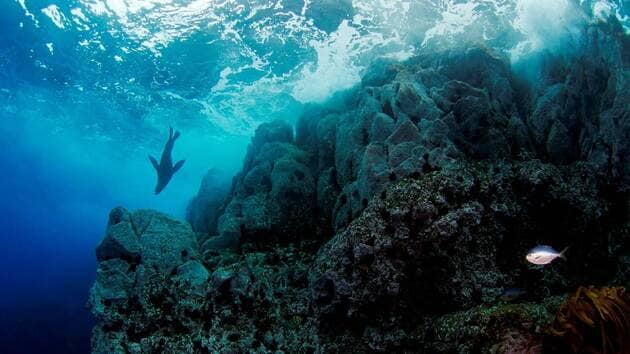
Four and a half years after commissioning its first LNG-powered ships, paving the way for new propulsion methods for container vessels of this size, CMA CGM has received the pioneer of its future methanol-powered fleet. This marks a paradigm shift for the French group, which has long advocated for pragmatic energy solutions.
On September 23, 2020, CMA CGM introduced the iconic Jacques Saadé, the flagship of a series of nine 23,000 TEU LNG-powered container ships named after Parisian landmarks. Now, the company welcomes its first « Methanol Powered » vessel, which remains dual-fuel. Built by South Korea’s Hyundai Samho, the CMA CGM Iron is the first in a series of twelve 13,136 TEU ships ordered in early 2023 at $171.35 million each, according to Alphaliner.
A New Fleet with a Metallic Theme
These 335-meter-long ships, named after metals from Mendeleev’s periodic table (Iron, Cobalt, Argon, Platinum, Mercury, etc.), are 51 meters wide with 20 container rows and 2,400 reefer plugs—positioning them at the high end of refrigerated cargo capacity. This feature is likely justified by the ship’s deployment on the Cimex 1 service, connecting Asia (Qingdao, Ningbo, Shekou, Singapore) and the Middle East (Khalifa Port, Abu Dhabi, Jebel Ali, Hamad, Dammam). This route has so far been operated by vessels ranging from 11,000 to 16,000 TEU, including the Marco Polo.
Four Years That Feel Like Ten
The reception of this methanol-powered vessel has been far less publicized than the introduction of the first LNG-powered ship, which was hailed as a “world-first” and a “concentrated innovation” after seven years of R&D. At the time, LNG was a controversial choice, with Rodolphe Saadé, CMA CGM’s CEO, standing alone in his conviction that it was the best immediately available solution for fleet decarbonization.
While LNG significantly reduces nitrogen and sulfur oxides, its CO₂ reduction is limited to about 20%. Meanwhile, CMA CGM’s competitors opted for retrofitting existing ships instead. But the world has changed rapidly: environmental regulations are tightening, and shipping companies are adapting. CMA CGM has since adjusted its approach, ordering LNG ships « ready for » bio-LNG and synthetic fuels and investing in bio and e-methanol propulsion.
In June 2022, the company announced plans to order six 15,000 TEU methanol-powered (dual-fuel) ships, followed by another twelve at the Assises de l’Économie de la Mer in Lille in November 2022.
Meanwhile, Maersk, a pioneer in green alternatives like methanol, has reversed course. After years of criticizing LNG due to methane slip issues, the company has now embraced LNG propulsion, recognizing its practicality amid regulatory uncertainties.
CMA CGM’s Methanol Fleet: 24 Dual-Fuel Vessels
CMA CGM’s methanol-powered fleet is now set to reach 24 vessels, forming part of its broader 131-ship low-carbon fleet strategy. The company has also partnered with Qingdao Beihai Shipbuilding Heavy Industry to convert ten 9,300 TEU ships to methanol, with the first scheduled for dry-docking soon in Qingdao.
While 75% of all ship orders in 2024 were for « green vessels, » enthusiasm for methanol has faded. According to Alphaliner, methanol-powered ships accounted for less than 30% of all new contracts in 2024—almost on par with conventional fuel-powered ships. Meanwhile, LNG propulsion has regained its status as the preferred choice for short- and medium-term decarbonization, representing 41% of total orders.
For large container vessels, where construction lead times extend beyond 2030 (the deadline for key regulations), LNG is increasingly seen as the most viable fuel. The only notable exception is MSC, which has ordered twelve 19,000 TEU conventionally powered ships from Zhoushan Changhong (for delivery between 2027-2029), designed for potential conversion to LNG, ammonia, or methanol.
Uncertain Fuel Supply
The biggest challenge for methanol propulsion remains fuel supply. While projections estimate 23 million tons of bio-methanol and e-methanol by 2029, production remains drastically low—just 0.5 million tons per year in 2024, with 3.6-6.1 million tons per year expected by 2030.
Maersk’s shift in strategy reflects this uncertainty. Initially, the company placed large orders for methanol-powered ships, hoping to stimulate production and lower costs. To secure fuel, Maersk has signed over ten long-term supply contracts, including a recent deal with LONGi Green Energy Technology, worth $250 million. These agreements cover half of the company’s expected methanol demand for 2027, but Maersk acknowledges in its 2024 annual report that fuel investments will depend on growth, IMO regulations, and other market uncertainties.
Expensive Green Fuel
Port regulations on methanol bunkering remain unclear. In Singapore, the world’s largest bunkering hub, alternative fuel sales reached 1.34 million tons in 2024, but methanol accounted for just 1,626 tons—a tiny fraction of the 300 million tons of fuel consumed annually by commercial ships.
Renewable methanol is also extremely expensive, costing around €1,500–1,600 per ton—four times the price of heavy fuel oil. According to H2V CEO Alexis Martinez, about half of that cost is due to electricity prices.
H2V plans to build six hydrogen production units in Marseille to supply heavy transport fuels like sustainable aviation fuel (SAF) and maritime methanol. However, scaling up such infrastructure will take time, adding further uncertainty to methanol’s future as a viable alternative fuel.
Source : actu-transport-logistique



